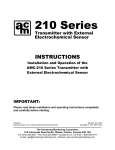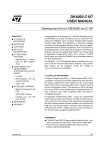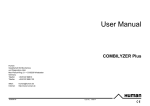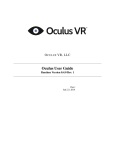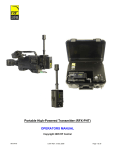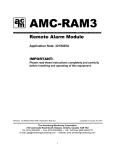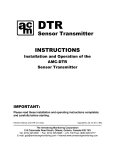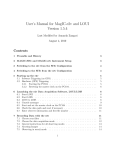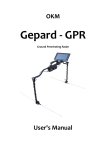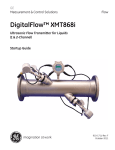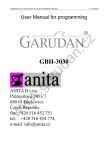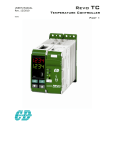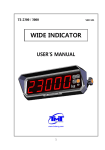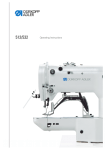Download AMC-400 Series - Armstrong Monitoring Corporation
Transcript
AMC-400 Series Digital Transmitter with Smart Sensor USER MANUAL IMPORTANT: Please read the installation and operating instructions completely and carefully before starting. Filename: 3242405A.doc Copyright ©, March 4, 2011, AMC The Armstrong Monitoring Corporation 215 Colonnade Road South, Ottawa, Ontario, Canada K2E 7K3 Tel: (613) 225-9531 • Fax: (613) 225-6965 • Canada & U.S. Toll Free: 1-800-465-5777 E-mail: [email protected] • Internet: www.armstrongmonitoring.com AMC-400 Series Digital Transmitter with Smart Sensor ii AMC-400 Series Digital Transmitter with Smart Sensor TABLE OF CONTENTS Section Title Page 1 GENERAL INFORMATION ...................................................................................... 1 1.1 WARRANTY....................................................................................................... 1 1.2 LIABILITY........................................................................................................... 1 1.3 PRODUCT RETURN ......................................................................................... 1 1.4 CONTACT INFORMATION................................................................................ 2 1.5 MODIFICATIONS AND SUBSTITUTIONS......................................................... 2 1.6 ORGANIZATION OF THE MANUAL.................................................................. 2 1.7 GLOSSARY ....................................................................................................... 3 2 PRODUCT INFORMATION...................................................................................... 4 2.1.1 2.1.2 TRANSMITTER MODULE SPECIFICATION ........................................................ 4 SENSOR MODULE(S) SPECIFICATION.............................................................. 4 3 PRODUCT DESCRIPTION ...................................................................................... 6 3.1 OVERVIEW........................................................................................................ 6 3.2 FRONT LID OVERVIEW .................................................................................... 7 3.3 REAR LID OVERVIEW ...................................................................................... 9 3.4 SMART SENSOR 2 OVERVIEW ..................................................................... 11 4 INSTALLATION ..................................................................................................... 13 4.1 LOCATION AND MOUNTING.......................................................................... 13 4.1.1 4.2 CONDUIT MOUNTING ........................................................................................14 WIRING............................................................................................................ 14 4.2.1.1 4.2.1.2 5 POWER SUPPLY .........................................................................................16 COMMUNICATION.......................................................................................16 OPERATION AND CALIBRATION ........................................................................ 18 5.1 OPERATION .................................................................................................... 18 5.1.1 5.1.2 5.1.3 5.1.4 5.1.5 5.2 5.3 TRANSMITTER JUMPER....................................................................................18 TRANSMITTER AND SMART SENSOR 2...........................................................18 TRANSMITTER STATUS LED ............................................................................21 TROUBLESHOOTING MODBUS USING THE TRANSMITTER STATUS LED ...22 SENSOR STATUS LED.......................................................................................23 INITIAL CONFIGURATION.............................................................................. 24 CALIBRATION ................................................................................................. 26 5.3.1 5.3.2 5.3.3 5.3.4 REQUIRED EQUIPMENT; EXCHANGE PROGRAM...........................................27 REQUIRED EQUIPMENT; ON-SITE CALIBRATION ...........................................27 CALIBRATION PROCEDURE .............................................................................27 GAS TEST AND SERVICE MODES ....................................................................29 6 MAINTENANCE ..................................................................................................... 31 6.1 GENERAL ........................................................................................................ 31 6.2 SCHEDULED CALIBRATION .......................................................................... 31 6.3 SENSOR/TRANSMITTER REPLACEMENT.................................................... 31 7 APPENDIX: DIGITAL TRANSMITTER CONFIGURATION MENU FLOW ............ 32 8 APPENDIX: DIGITAL TRANSMITTER CALIBRATION MENU FLOW.................. 33 9 APPENDIX: USER SUPPORTED MENU GUIDE .................................................. 34 10 APPENDIX: MODBUS REGISTER MAP............................................................ 39 iii AMC-400 Series Digital Transmitter with Smart Sensor LIST OF FIGURES Figure Title Page Figure 3-1 Front Lid View........................................................................................................... 7 Figure 3-2 Rear Lid View ........................................................................................................... 9 Figure 3-3 Smart Sensor 2 View ...............................................................................................11 Figure 4-1 Conduit Mounting.....................................................................................................14 Figure 4-2 Example of Electrical Wiring of Digital Transmitter(s) ...............................................15 Figure 4-3 Example of Connections to a AMC-1DAX Monitor ...................................................16 Figure 5-1 Front Panel User Interface .......................................................................................20 iv AMC-400 Series Digital Transmitter with Smart Sensor 1 GENERAL INFORMATION 1.1 WARRANTY The AMC-400 Digital Transmitter is warranted against defects in material and workmanship for a period of two years from date of delivery. Maintenance items are not warranted. During the warranty period, The Armstrong Monitoring Corporation will repair or replace components that prove to be defective in the opinion of AMC. Any equipment deemed to be defective by the user should be returned to The Armstrong Monitoring Corporation for evaluation (see product return below). Site visits by Armstrong personnel, to evaluate/repair equipment, are not covered by this warranty unless covered under site contract. AMC is not liable for auxiliary interfaced equipment, nor for consequential damage. This warranty shall not apply to any product, which has been modified in any way, which has been repaired by any other party other than a qualified technician or authorized AMC representative, or when failure is due to misuse or conditions of use. Note: extended warranty mail in calibration programs is available (please call 1-800-4655777) or through contacts at www.armstrongmonitoring.com 1.2 LIABILITY All AMC products must be installed and maintained according to instructions. qualified personnel should install and maintain the equipment. Only AMC shall have no liability arising from auxiliary interfaced equipment, for consequential damage, or the installation and operation of this equipment. AMC shall have no liability for labor or freight costs, or any other costs or charges in excess of the amount of the invoice for the products. THIS WARRANTY IS IN LIEU OF ALL OTHER WARRANTIES, EXPRESSED OR IMPLIED, AND SPECIFICALLY THE WARRANTIES OF MERCHANTABILITY AND FITNESS FOR A PARTICULAR PURPOSE. THERE ARE NO WARRANTIES THAT EXTEND BEYOND THE DESCRIPTION ON THE FACE THEREOF. WARNING CHECK TO ASSURE THE WORKING AREA IS FREE FROM HAZARDS DURING INSTALLATION OR WHEN PERFORMING MAINTENANCE, AND USE PROPER PRECAUTIONS. 1.3 PRODUCT RETURN All products returned for warranty or service should be shipped by prepaid freight and will be accepted only with RMA or repair number issued by AMC. All products returned to the client will be shipped by freight collect. 1 AMC-400 Series Digital Transmitter with Smart Sensor 1.4 CONTACT INFORMATION For information please call 1-800-465-5777 or through contacts at www.armstrongmonitoring.com or through email directly at [email protected]. 1.5 MODIFICATIONS AND SUBSTITUTIONS Due to an ongoing development program, AMC reserves the right to substitute components and change specifications at any time without incurring any obligations 1.6 ORGANIZATION OF THE MANUAL This manual provides the following major sections: 1. PRODUCT DESCRIPTION - This section illustrates the product features with a brief description. 2. INSTALLATION – This section illustrates the installation of the product, describing the mounting, wiring for power and communication. 3. OPERATION AND CALIBRATION – This section discusses in detail the operation and procedure for operating and calibrating this product. 4. MAINTENANCE – This section list the maintenance schedule and options associated with this product. 2 AMC-400 Series Digital Transmitter with Smart Sensor 1.7 GLOSSARY Alarm Calibration Calibration Gas DT Gas Concentration PPM Percent by volume RS-485 Span SS2 T90 T99 Zero Buffering Zero Gas Alarm is an audible, visual, or physical presentation designed to warn the instrument user that a specific level of a dangerous gas/vapor concentration has been reached or exceeded. Calibration is the procedure used to adjust the instrument for proper response. Calibration Gas is a gas of known concentration(s) used to set the instrument span or alarm level(s). Digital Transmitter Gas Concentration is measured: • PPM Parts Per Million (1% volume = 10,000PPM) Concentration of gas in a mixture expressed as a percentage of total volume. Superseded with EIA-485 or TIA-485 Full range of a sensor i.e. a CO sensor with a full scale of 0-100 PPM has a 100 PPM span. Smart Sensor 2 Response Time in seconds to achieve 90% gas concentration reading. This a typical calibration point that allows for sensor aging, but tends to be less accurate than a T99 calibration, Response Time in seconds to achieve 99% gas concentration reading. This is a more accurate calibration point. Zero buffering is transmitter function which forces the gas concentration reading to zero when sensor is exposed to low concentration of a gas. The zero buffers is provided in the sensor specification. Zero gas is gas with no concentration. Clean air is an excellent source for zero calibration. A known gas concentration can be entered during zero calibration. 3 AMC-400 Series Digital Transmitter with Smart Sensor 2 PRODUCT INFORMATION The AMC-400 Series Digital Transmitter with Smart Sensor is a two part assembly; Transmitter and Smart Sensor module. Both modules have Microcontroller (MCUs) to manage and communicate the information in a digital formal. The Transmitter communicates with a monitor (i.e. AMC-1DAX) and carries a Smart Sensor module. The monitor and transmitter communicate to each other over RS-485 using MODBUS/RTU. The smart sensor acquires data from an electrochemical gas sensor and communicates its gas concentration to the transmitter. The smart sensor module is designed for modular Exchange Program for calibration purpose. Note: All Armstrong Monitoring systems must be installed and maintained according to instructions to assure proper operation. Only qualified personnel should install and maintain the equipment. For exchange, re-calibration or extended warranty programs information please call 1-800-465-5777 or through contacts at www.armstrongmonitoring.com 2.1.1 TRANSMITTER MODULE SPECIFICATION Transmitter Order Number…………... ………... Power Supply Requirement…………………….. Two Wire optional Shield 12 to 24 VDC/AC Warranty………………………………… 2 Years Operating ………………………… Operating …………………………….. Relative ……………………………….. AMC-400A Temperature -20° to 50° C Pressure 0.9 to 1.1 atm Humidity 15 to 90% RH, non-condensing Two Wire with Shield Modbus RTU over RS-485 9600 Baud, 8bit Even Parity. Signaling…………………………………... 2.1.2 SENSOR MODULE(S) SPECIFICATION Gas Type………………………………….….…... CARBON MONOXIDE (CO) Sensor Order Number…………………….…… AMC-91A0F Sensor Height Above Finished Floor 4-6 Feet 4 AMC-400 Series Digital Transmitter with Smart Sensor Sensor Life…….………………………………… 6 Years Sensor Warranty………………………………… 3 Years Span Gas …………………………...…………… 0-100ppm Zero Buffering of Display Calibration Adapter Number……………… <8ppm Part AMC-C1-FK1 Gas Flow Rate .5L/min. Gas Type………………………………….….…... NITROGEN DIOXIDE (NO2) Sensor Order Number…………………….…… AMC-98AHC Sensor Height Above Finished Floor 4-6 Feet Sensor Life…….………………………………… 2 Years Sensor Warranty………………………………… 1 Years Span Gas …………………………...…………… 0-10.0ppm Zero Buffering of Display Calibration Adapter Number……………… <0.8ppm Part AMC-C1-FK2 Gas Flow Rate .5L/min. 5 AMC-400 Series Digital Transmitter with Smart Sensor 3 PRODUCT DESCRIPTION The AMC-400 Digital Transmitter is designed to provide continuous, reliable monitoring of ambient air for the target gas listed in the SENSOR MODULE(S) SPECIFICATION. This unit is hot pluggable and powered by either AC or DC power source and provides digital representation of the gas concentration detected. A digital gas concentration display is provided, which may be configured to remain blank. Each sensor/transmitter unit is factory calibrated, and is ready for field installation and operation. Each sensor module features alarm indicators and connection terminal blocks, as listed and described below. 3.1 OVERVIEW The AMC-400 Digital Transmitter consists of three main components; • • • PVC Enclosure, Lid Assembly, Smart Sensor 2 Assembly. The following three drawings are provided to briefly describe these components. 6 AMC-400 Series Digital Transmitter with Smart Sensor 3.2 FRONT LID OVERVIEW Display 2 4 Smart Sensor 2 status LED 5 Modbus Address 3 Transmitter status LED 6 Sensor & Vent 7 Push button 1 Enclosure Figure 3-1 Front Lid View 7 AMC-400 Series Digital Transmitter with Smart Sensor 1. Enclosure: 2. Digital Display: 3. Transmitter Status LED: 4. Smart Sensor 2 Status LED: 5. MODBUS Address 6. Sensor & Vent 7. Pushbutton: Enclosure and Lid Assembly, PVC 4”x4” Wall mount with mount points. Enclosure Lid attaches with four screws. Displays gas concentration & Status information, 3 Digit User Interface for configuration Red/Green LED Indicates status of Transmitter. Red/Green LED Indicates status of integral Smart Sensor. This is a write on area matching the MODBUS node ID (Address). The indication here may be factory set and can be changed as needed. This vent allows target gas to flow into the sensor. The vent is also used for gas calibration. Momentary On/Off Pushbutton User Interface for Configuration. 8 AMC-400 Series Digital Transmitter with Smart Sensor 3.3 REAR LID OVERVIEW 14 Modbus Termination 13 Smart Sensor 2 Termination 12 SS2 female connector 15 SS2 mounting hole Transmitter board Sensor SS2 Board mounted Mounting Standoffs RS485 A RS485 B CGND SIG GND AC 1 AC 2 GND VDD V+ SS2 board 11 10 9 8 V+ test point VDD test point GND test point Power and communication connector Figure 3-2 Rear Lid View Note: When mounting the Smart Sensor module, it is possible for its male header pins to miss the receptacle of the Digital transmitter completely. Warning: Care must be taken when connecting services to Power and Communication Connector. Avoid using SIG GND for powering. Cable shield(s) are to be connected to CGND. Mixing power and communication connections can cause permanent damage. Consistent polarity of RS-485 wire is required throughout network for proper system operation. 9 AMC-400 Series Digital Transmitter with Smart Sensor 8. Power and Communication Connector: This 6 pin male plug connector contains both power and communication network connection points. The power is normally 24VDC and the communication network is MODBUS over RS-485. 9. GND Test Point: This GND Test Point is to be used by service technicians only with appropriate instrumentation such as a voltmeter. It is the signal reference point for the digital transmitter control logic. 10. VDD Test Point: This VDD Test Point is to be used by service technicians only. It is the digital transmitter control logic supply voltage and must be 5+-5% Volts DC. 11. V+ Test Point: This V+ Test Point is to be used by service technicians only. It is the digital transmitter rectified unregulated power input and must be 8-35 Volts DC. 12. SS2 Female Connector: This 7 pin connector mates with the Smart Sensor 2 Assembly male connector. This connector carries the power and communication for Smart Sensor 2. 13. Smart Sensor 2 Termination: Default position: AC Termination (Pins 1-2). This termination allows AC or DC Termination for the Smart Sensor II RS-485 signaling. 14. MODBUS Termination: Default position: No Termination (Pin 2). This termination allows AC or DC Termination for the MODBUS RS-485 signaling. Use AC Termination (Pin 12) when transmitter is an end point on bus. 15. SS2 Mounting Hole: This mounting hole contains two standoffs to support the Smart Sensor II Assembly. One standoff is a stud the other is nylon press-fit. 10 AMC-400 Series Digital Transmitter with Smart Sensor 3.4 SMART SENSOR 2 OVERVIEW Smart Sensor 2 Board 16 SS2 male connector SIG Front Back 22 21 3 4 5 7 8 9 0 VER 2 6 REV 1 1 2 3 4 5 6 7 8 9 0 CTR VREF test point 19 SNS1 SIG CTR VREF 20 Sensor Location GND SNS4 VDD SNS2 SNS3 18 VDD test point 17 GND test point Figure 3-3 Smart Sensor 2 View 16. SS2 Male Connector: This 7 pin connector mates with the Digital Transmitter Assembly female connector. This connector carries the power and communication. 17. GND Test Point: This GND Test Point is to be used by service technicians only with appropriate instrumentation such as a voltmeter. It is the signal reference point for the smart sensor 2 control logic. 18. VDD Test Point: This VDD Test Point is to be used by service technicians only. It is the smart sensor 2 control logic supply voltage and must be 3.42 to 3.78 Volts DC. 11 AMC-400 Series Digital Transmitter with Smart Sensor 19. VREF Test Point: This VREF Test Point is to be used by service technicians only. It is the potentiostat sensor reference and must be 1.8 Volts DC. 20. Sensor: This component may be a variety of 2 or 3 pin electrochemical sensors. This component is securely fastened with glue to Smart Sensor 2 Assembly. 21. CTR Test Point: This CTR Test Point is to be used by service technicians only with appropriate instrumentation such as a voltmeter. It is the potentiostat counter output used by a 3 pin electrochemical sensor. Under ideal operation zero gas situation it is normally 1.8 Volts DC VREF. 22. SIG Test Point: This Sig Test Point is to be used by service technicians only with appropriate instrumentation such as a voltmeter. It is the potentiostat sensor output used. Under normal operation zero gas situation it tracks the 1.8 Volts DC VREF. When CO gas is applied this SIG Test Point increases toward 3.6 Volts DC. When NO2 gas is applied this SIG Test Point decreases towards 0 Volts DC. 12 AMC-400 Series Digital Transmitter with Smart Sensor 4 INSTALLATION The installation of the AMC-400 Digital Transmitter is very important as the operational quality is a direct result of the quality of the installation. The following sections provide guidelines for installation; location and mounting, wiring, and cable selection. 4.1 LOCATION AND MOUNTING Mount the AMC-400 Digital Transmitter sensor/transmitter on a solid, non-vibrating surface or structure in an area where the ambient concentration of gas is not directly affected by the presence of clean air supply, ventilation systems, or blockage by surrounding articles and sources of interference gases. Please, refer to local codes for sensor/transmitter installation information. The installer is required to provide any mounting hardware that may be required. The AMC-400 Digital Transmitter sensor/transmitter circuit board(s) with sensor is removable from the enclosure for ease of installation. The recommended mounting height is specified in the SENSOR MODULE(S) SPECIFICATION. The conduit entry is from bottom of box to avoid moisture flow into box through conduit. Notes: Mount enclosure with the sensor located as shown is Figure 4-1. This will ensure correct orientation. Warning: It is possible to damage both the Smart Sensor 2 and Digital Transmitter assemblies if Smart Sensor 2 is plugged or unplugged under power. This product does not support hot powering of the Smart Sensor 2 unit. Please completely disconnect power from Digital Transmitter before replacing Smart Sensor 2 assembly. Installing conduit from top of box will allow moisture from condensation to drip down into circuit assembly. Damage caused by this type of installation will void warranty. Caution: Conduit entry is from the bottom of enclosure to avoid damage to electronic components from condensation build-up in the conduit. 13 AMC-400 Series Digital Transmitter with Smart Sensor 4.1.1 CONDUIT MOUNTING 4.600 Mounting screws (4 places) Ø0.200 2.100 2.470 (4Plcs) 23 Mounting holes Wiring Conduit Wiring Figure 4-1 Conduit Mounting 23. Mounting Holes: Wall mounts with 4 holes. 4.2 WIRING The AMC-400 Digital Transmitter employs a four wire system which has two main wiring systems: the monitor communication (two wires) and power supply wiring (two wires). A two conductor, shielded cable is used to connect the RS-485 signals from the AMC-400 Digital Transmitter to the monitor. A two conductor, shielded cable is recommended to connect the power from the AMC400 Digital Transmitter to the power supply. Shielded cable is optional for power supply wiring. For best signal transmission and maximum noise rejection, it is recommended to connect the cable shields to chassis ground at the monitor. Below are example electrical wiring diagrams for an application where monitor supplies both power and communication. 14 AMC-400 Series Digital Transmitter with Smart Sensor Warning: Installing monitor communication without shield will produce unreliable system wide failure. Armstrong Monitoring Corporation will not support this type of installation. To Monitor AC2 AC1 CGND RS 485 B RS 485 A Unit 1 Unit 2 RS 485 A RS 485 A RS 485 B RS 485 B CGND CGND SIGGND SIGGND AC1 AC1 AC2 AC2 Figure 4-2 Example of Electrical Wiring of Digital Transmitter(s) MONITOR AC modbus termination on last unit Unit 1 R1 R2 R3 R4 STATUS DISPLAY 1 2 3 CAL 4 5 6 CONTROL 7 SETUP 8 0 1 2+ 3 4+ 5 6+ 7 8 + 9 24 VDC PWR 10 + 11 12 + NETWORK Unit 2 IN 9 ENTER CHASSIS GND POINTS RS 485 A RS 485 B CGND SIG GND AC 1 AC 2 GND VDD V+ GND VDD V+ CONNECTOR Note 1. There is always AC modus termination on the last transmitter connected in the system 2. More than 2 transmitters can be connected to a single monitor 3. Power shielded cabling is optional 15 1 2 3 4 5 6 7 8 9 10 11 12 24 VDC PWR IN NETWORK AMC-400 Series Digital Transmitter with Smart Sensor Figure 4-3 Example of Connections to a AMC-1DAX Monitor Warning: Care must be taken when connecting services to Power and Communication Connector. Avoid using SIG GND for powering. Cable shield(s) are to be connected to CGND. Mixing power and communication connections can cause permanent damage. Consistent polarity of RS-485 wire is required throughout network for proper system operation. 4.2.1.1 POWER SUPPLY The AMC-400 Digital Transmitter assembly is to be powered by the AMC-1DAX monitor Power Supply. An AMC-400 Digital Transmitter is powered through a cable on AC1 and AC2 connections as shown in the REAR LID OVERVIEW; item 8 Power and Communication Connector:. The rectified unregulated V+ Test Point: voltage must be between 8 and 42 Volts DC. The shield of the cable should be connected to chassis ground on CGND at the monitor power supply and the AMC-400 Digital Transmitter. Caution: Care must be taken when installing to ensure that all Digital Transmitters are connected with the same power supply polarity across the network. Digital Transmitter AC2 should be connected to + power terminal and Digital Transmitter AC2 should be connected to – power terminal. Using SIG GND for powering should be avoided. The recommend power cable should be a two wire conductor plus shield cable with #18 AWG. The cable length must not exceed a distance that prevents the Digital Transmitter from obtaining a minimum voltage of 8 Volts DC at V+ Test Point. 4.2.1.2 COMMUNICATION The AMC-400 Digital Transmitter assembly is to be controlled by the AMC-1DAX monitor or other MODBUS masters. The AMC-1DAC has the possibility of managing 80 nodes on the network. All nodes are connected to same two communication signals; RS485A and RS485B. The AMC-400 Digital Transmitter communicates through a cable connection on RS485A and RS485B as shown in the REAR LID OVERVIEW; item 8 Power and Communication Connector: Caution: Care must be taken when installing to ensure that all Digital Transmitters are connected with the same MODBUS polarity across the network. Digital Transmitter RS485A should be connected to + network terminal and Digital Transmitter RS485B should be connected to – network terminal. Using SIG GND for powering should be avoided. The recommend cable should be a two wire twisted pair conductor plus shield cable and has a characteristic impedance of 120ohms. 16 AMC-400 Series Digital Transmitter with Smart Sensor The total cable length for the entire network should not exceed 1000 M. Please refer to MODBUS OVER SERIAL LINE SPECIFICATION AND IMPLEMENTATION GUIDE V1.0 27/44 This cable should be a two wire twisted pair conductor shielded cable. The shield of the cable should be connected to chassis ground on CGND at the monitor and the AMC-400 Digital Transmitter. MODBUS AC termination is required for last unit of bus; please refer to REAR LID OVERVIEW MODBUS Termination; item #14 for details. 17 AMC-400 Series Digital Transmitter with Smart Sensor 5 OPERATION AND CALIBRATION This section describes how the functionalities of the AMC-400 Digital Transmitter are operated and performed. Please consult the operation and initial configuration chapters below before attempting to operated the AMC-400 Digital Transmitter. Warning: It is possible to damage both the Smart Sensor 2 and Digital Transmitter assemblies if Smart Sensor 2 is plugged or unplugged under power. This product does not support hot powering of the Smart Sensor 2 unit. Please completely disconnect power from Digital Transmitter before replacing Smart Sensor 2 assembly. 5.1 OPERATION 5.1.1 TRANSMITTER JUMPER The Digital Transmitter has two straps; Smart Sensor 2 Termination and MODBUS Termination. Please refer to REAR LID OVERVIEW for details. 5.1.2 TRANSMITTER AND SMART SENSOR 2 The AMC-400 Digital Transmitter sensor/transmitter is factory calibrated for the gas listed in the Product Information (Section 2) at the beginning of this manual. The sensor/transmitter should not require re-calibration when first installed and powered up, but a test for correct sequence of operation is recommended after a stabilization period of five minutes. Activity on the LED(s) indicates that the board is powered on. At power up, the display runs through the following sequence: 1. Indicates the software/Hardware versions and performs a self test 2. Display sensor stabilization status 3. Displays the gas type 4. Displays the detected level Note: The transmitter will experience a reboot and repeat the above sequence if no MODBUS traffic is detected for a period of five minutes. Additionally a failed transmitter will reboot after one to two minutes. Additionally the AMC-400 Digital Transmitter can insert other sensor status between gas type and gas concentration. This following sensor status is available: 18 AMC-400 Series Digital Transmitter with Smart Sensor Sensor Status “PUP” Definition Sensor in stabilization Power Up Period “CAL” Sensor needs CALibration “OFL” Sensor in Over Flow out of range state. Gas concentration is exceeding full span range of sensor. “EOL” Sensor has reached End Of Life Action Wait up to 5 minutes for sensor to stabilize. Consult CALIBRATION and MAINTENANCE sections in this manual. Consult AMC for appropriate Smart Sensor type and use. It is not recommended to operate Smart Sensor outside specified operating limits. Gas concentration is this mode may be at hazardous levels. Contact AMC for replacement. Sensor operated beyond EOL may provide erroneous readings. In near zero gas and after the stabilization period, the transmitter will send accurate gas concentration MODBUS packets to the monitor or controller. Although the electrochemical sensors are very selective, there are some interference gases which can cause a response from the sensor. In the case of a large response, please check background gas potential or the possibility of an interference gas being present. Caution: When the gas concentration exceeds the full scale range, the display will alternate between the reading value and the letters “OFL” for overflow. Refer to 2.1.2 SENSOR MODULE(S) SPECIFICATION for SPAN, consult AMC for alternative Smart Sensor 2 types. It is not recommended to operate Smart Sensor outside specified operating SPAN. Gas concentration is this mode may be at hazardous levels. The front panel view below shows the four areas of user interface; Pushbutton, Display, TX Status, and Sensor Status. These user interfaces are briefly described below and referenced in more detail under the initial configuration and calibration sub-sections. 19 AMC-400 Series Digital Transmitter with Smart Sensor Figure 5-1 Front Panel User Interface Note: The Pushbutton (reference point 1) is positioned behind the front panel and requires a small TOOL SCREWDRVR SLOT ESD 1.5MM, Wiha 27215 to access it through a small hole. The Pushbutton allows a user to navigate through configuration menu. The pushbutton has two states; short and long button press. Short press is less than two seconds while long press is greater than two seconds. Feedback of the pushbutton state is provided on the display. A short press will display both decimal points, while a long press will display “SEL”. As an example the pushbutton must be pressed and held for at least 2 seconds to enter configuration. The display will indicate “SEL” when user has held the pushbutton long enough to enter the configuration menu. The Display has 3 character positions with two decimal points, each character has 7 segments. The LCD can display numbers and various alphabetic characters. Some alphabetic characters are upper case while others are lower case. In normal operation the display will cycle between the gas concentration and gas type, in configuration the display is used to indicate configuration titles and items. By default the Gas concentration is displayed in PPM and may or may not have a decimal point. The Gas type is displayed in alphanumerical characters as an example “co” indicates Carbon Monoxide and “no2” indicates Nitrogen Dioxide. The TX Status is a green and red LED to indicate activity of the MODBUS link and transmitter health and state. As an example a slow blinking green TX status indicates 20 AMC-400 Series Digital Transmitter with Smart Sensor healthy MODBUS activity detected, while a period of fast blinking red TX status can indicate a momentary MODBUS fault. Please refer to TRANSMITTER STATUS LED for further details. The Sensor Status is a green and red LED to indicate activity of the Smart Sensor link and Smart Sensor health and state. As an example a slow blinking green Sensor status indicate healthy activity detected, while a period of fast blinking red Sensor status can indicate a momentary sensor bus fault. Please refer to SENSOR STATUS LED for further details. Note: AMC-400 Digital Transmitter LED will appear to blink slow green even though it is not being accessed by a monitor. This is the case when MODBUS address is not properly configured. Use 5.3.4 GAS TEST AND SERVICE MODES to verify proper configuration this will allow gas concentration to be observed at the monitor or controller. 5.1.3 TRANSMITTER STATUS LED The Transmitter Status LED under normal operation should be slow blinking green indication. Slow blinking green indicates MODBUS communication detected and no transmitter faults. Numerous transmitter faults can occur under various situations and is indicated with momentary fast blinking red indication. A fast blinking green indicated no MODBUS communication present and no transmitter faults. Note: AMC-400 Digital Transmitter Status LED will momentarily fast blink red under a minor transmitter fault situation, such as erroneous MODBUS packet. Consult AMC for service if minor transmitter fault persists. 21 AMC-400 Series Digital Transmitter with Smart Sensor Below is the possible Transmitter Status LED: Transmitter LED State Definition Slow Blinking Red Transmitter initializing. Slow Blinking Green Transmitter is healthy. Fast Blinking Green Transmitter is healthy, but no MODBUS communication detected. Slow Blinking Transmitter is in Green/Red configuration mode. Fast Blinking Transmitter is in Green/Red gassing state of calibration. Fast Blinking Red Transmitter has experienced a minor fault in the last 10 seconds of operation. Solid or long period Red, Green or Orange LED Extinguished Transmitter has experienced a severe fault. Transmitter is powered off. Action Wait for initialization to complete. No action required. Check if monitor is MODBUS connected and not in setup. Complete configuration and exit. Complete calibration and exit. Check if transmitter and/or other system components have valid operating limits (i.e. connections, power supply, temperature, and MODBUS addressing). Consult AMC for service if status persists. Wait one to two minutes for unit to enter normal mode. Consult AMC for service if status persists. Check transmitter wiring or power supply state. Consult AMC for service if status persists. 5.1.4 TROUBLESHOOTING MODBUS USING THE TRANSMITTER STATUS LED The Transmitter Status LED indirectly provides a MODBUS monitor function. Using this LED in conjunction with other transmitters can help in diagnostic of MODBUS faults. Here is a list of troubleshooting guidelines of the Transmitter Status LED: A. If all transmitters blink fast green and the monitor is in operation mode then the MODBUS wiring is likely disconnected at the monitor. B. If one or more transmitter(s) in a chain are blinking fast green and a unit closer to the monitor is blinking slow green then a MODBUS disconnection point begins after the slow blinking green unit. C. If a transmitter is blinking fast red and other transmitter units are blinking slow green then check that the MODBUS connections are not reversed on the flashing red unit. D. If a transmitter blinks slow green, but the monitor indicates “na” for that unit then the transmitter unit needs its MODBUS address to be assigned. E. If two transmitter units blink slow green, but all other transmitter units indicate fast blinking red, then the two slow blinking green transmitter units have the same MODBUS address. F. If the monitor appears to be operating well with one or more transmitters, but transmitter unit(s) have fast blinking red from time to time, then MODBUS signal degradation is present. Check that the both MODBUS signals wires and shield are properly connected. 22 AMC-400 Series Digital Transmitter with Smart Sensor 5.1.5 SENSOR STATUS LED The Sensor LED Status under normal operation has a slow blinking green indication. Slow blinking green indicates good Smart Sensor communication detected and no sensor faults. Numerous sensor faults can occur under various situations and is indicated with momentary fast blinking red indication. Caution: Sensor LED status will momentarily fast blink red under a minor sensor fault situation, such as a packet error. Consult AMC for service if minor sensor fault persists. Below is the possible Sensor LED Status: Sensor LED State Definition Slow Blinking Red Smart Sensor initializing. Slow Blinking Green Smart Sensor is healthy. Fast Blinking Green Smart Sensor is healthy, but no communication detected. Slow Blinking Smart Sensor is in Green/Red configuration mode. Fast Blinking Smart Sensor is in Green/Red gassing state of calibration. Blinking Red for Smart Sensor requires 10seconds every services either minute of Slow calibration or has Blinking Green reached end of life. DT display will complement this with “CAL” or “EOL” indication. Fast Blinking Red Smart Sensor has experienced a minor fault in the last 10 seconds of operation. Solid or long period Red, Green or Orange LED Extinguished Smart Sensor has experienced a severe fault. Smart Sensor is powered off. Action Wait for initialization to complete. No action required. Check if Smart Sensor is properly connected to TX. Complete configuration and exit. Complete calibration and exit. Consult calibration section in this manual or contact AMC. It is not recommended to operate Smart Sensor after end of life or when calibration is needed. Sensor operated beyond CAL or EOL may provide erroneous readings. Check if Smart Sensor has valid operating limits (i.e. power supply, temperature, and Smart Sensor addressing). Consult AMC for service if status persists. Wait one to two minutes for unit to enter normal mode. Consult AMC for service if status persists. Check Smart Sensor wiring or power supply state. Consult AMC for service if status persists. Note: The Smart Sensor will experience a reboot and enter initialization state (slow blinking RED Sensor Status LED) if no transmitter requests are detected for a period of five minutes. Additionally a failed Smart Sensor will reboot after one to two minutes. 23 AMC-400 Series Digital Transmitter with Smart Sensor 5.2 INITIAL CONFIGURATION Initial installation requires a unique MODBUS address to be configured. The current MODBUS address may be pre-configure and labeled on the front panel in small box (see front panel view item 5). User can change the MODBUS address by entering configuration. MODBUS addresses must be in the range of 1-247. Please refer to Appendix for menu flow diagrams and guide. Caution: An invalid MODBUS address may cause other devices to malfunction. It is important to carefully map out MODBUS addresses. Note: AMC-400 Digital Transmitter will automatically exit current level of configuration after 1 minute of inactivity without change. This can be useful when user is lost or unsure of current modification. The AMC-400 Digital Transmitter configuration is divided into 6 areas; • • • • • • MODBUS Configuration Smart Sensor Configuration Digital Transmitter Configuration Zero Calibration Span Calibration Service Modes 1. To enter configuration press and hold the pushbutton for 2 seconds or more until the display shows “SEL”. When the pushbutton is released the Configuration Menu title “-CF” will be displayed. 2. The possible items in configuration are: “-CF” Configuration Title and Exit Point “A01” MODBUS Configuration “A02” Smart Sensor Configuration “A03” Digital Transmitter Configuration “A04” Zero Calibration “A05” Span Calibration “A06” Service Modes 3. At this point the user can immediately exit configuration by push and holding the pushbutton for >2 seconds and releasing. Alternatively the user can scroll through the above 6 choices by short pressing the pushbutton (<2seconds). The list is circular in nature. Note: Configuration titles with a negative sign are exit points. Just press and hold the 24 AMC-400 Series Digital Transmitter with Smart Sensor pushbutton for >2seconds and release to get to the previous level. Scrolling with quick button presses will normally cycle you to an exit point without change. 4. To enter MODBUS Configuration the user must press and hold the pushbutton for >2 seconds and release at the item A01. The MODBUS title “-FB” will be displayed. 5. To configure the MODBUS address short press to the item “F01” and press and hold for >2seconds and release to enter sub-item. At this point the current MODBUS address will be displayed; a short press returns you back to “F01” which can lead you to an exit point. 6. To modify the MODBUS address press and hold for >2seconds and release to edit the first digit of the address. The least significant digit can now be changed, scroll quickly with short presses and cycle through the number choices from the current number to 9 and then back to 0. Press and hold >2seconds and release to move to next most significant digit position. Repeat sequence for second digit and third digit. When the MODBUS address is displayed use a short press to return to “F01”. 7. Use short presses to scroll to item “-FB” and push and hold the pushbutton for >2 seconds and release to return to A01. Use short presses to scroll to item A03. 8. To enter Digital Transmitter Configuration the user must push and hold for >2seconds and release at item A03. The title “-du” will be displayed. Scroll through to d01, push and hold for >2seconds and release to enable LCD blanking. LCD will blank after 1 minute of pushbutton inactivity, pressing the pushbutton restores display. Alternatively scroll to d02, push and hold for >2seconds and release to disable LCD blanking. Or scroll to d03, push and hold for >2seconds and release to enter Digital Transmitter location label. Location labeling allows a unique 3 character string to be assigned to Digital Transmitter. This procedure is similar to entering the MODBUS address, but the choices are alphanumeric. Note: Currently location label is not required by a monitor or controller and can be used as needed to store and retain user information. 9. Items A04 to A06 can be skipped for initial configuration. 25 AMC-400 Series Digital Transmitter with Smart Sensor 5.3 CALIBRATION This calibration procedure is applicable for all versions of the AMC-400 Digital Transmitter. Every AMC-400 Digital Transmitter sensor/transmitter is factory calibrated, so each unit is to be ready for operation after installation and a 5 minute stabilization time. The AMC-400 Digital Transmitter and Smart Sensors are equipped with Calibration and End of Life indicators. When calibration or sensor End of Life has occurred the display will interleave “CAL” or “EOL” respectively during normal gas concentration updates. Subsequent calibration is required as a part of regular maintenance, and when replacing the sensor. See the Maintenance section of this manual for the recommended calibration schedule. Note: When the gas sensor needs calibration or has reached end of life the display will alternate between the reading value and the letters “CAL” or “EOL”. Warning: When performing calibration the results are not saved in Smart Sensor until successful Span procedure has been completed. Powering off unit after Zero procedure and before completing a successful Span procedure will result in calibration information being lost. Also failed Span procedure due to user abort or procedure limit checking leaves the unit with unstable calibration information. It is important to complete a successful SPAN procedure for unit to function properly. Caution: - Only qualified personnel should perform the actual calibration. - Users new to gas calibration are advised to consult with Armstrong Monitoring The Armstrong Monitoring Corporation offers the following calibration plans: 1. Factory pre-calibrated exchange replacement smart sensor units 2. On site installation by Armstrong Monitoring 3. On site calibration by Armstrong Monitoring 4. Training by Armstrong Monitoring for end users For additional details please refer to CONTACT INFORMATION. 26 AMC-400 Series Digital Transmitter with Smart Sensor 5.3.1 REQUIRED EQUIPMENT; EXCHANGE PROGRAM For qualified personnel, the following is a recommended list of equipment required. • • 5/16 Nut driver and Philips and Roberson screw driver set TOOL SCREWDRVR SLOT ESD 1.5MM, Wiha 27215. To replace Smart Sensor 2 with pre-calibrated unit, first completely remove power from Digital Transmitter by unplugging Power and Communication Connector as shown in. Use a Nut driver to remove nut that is holding Smart Sensor 2 assembly to Digital Transmitter. Carefully remove and replace Smart Sensor 2 assembly attached to SS2 Female Connector. Replace nut holding Smart Sensor2 to Digital Transmitter with Nut driver. Warning: It is possible to improperly insert SS2 Male Pins into SS2 Female connector. 5.3.2 REQUIRED EQUIPMENT; ON-SITE CALIBRATION For qualified personnel, the following is a recommended list of calibration equipment required. • • TOOL SCREWDRVR SLOT ESD 1.5MM, Wiha 27215 Calibration kit, please refer to SENSOR MODULE(S) SPECIFICATION. 5.3.3 CALIBRATION PROCEDURE The AMC-400 Digital Transmitter is equipped with a calibration feature allowing for oneman calibration at the transmitter location. In most cases it is only Zero and Span adjustments that are made in field calibrations. All Calibration procedures will automatically exit to normal operation without change if left inactive for several minutes. Please refer to Appendix for menu flow diagrams and guide. Note: During calibration new gas concentration is not updated to monitor and last gas concentration value will be reported. Refer to Figure 5-1 Front Panel User Interface to perform the following calibration procedure: 1) Cover the sides of sensor with a clean cloth or similar to prevent a draft on the sensor. The zero calibration can also be used with a gas concentration for a 2 point calibration procedure (as example 5ppm CO gas could use instead of 0ppm). Perform gassing with a calibration adapter that is firmly inserted into front panel of AMC-400 Digital Transmitter; please refer to 2.1.2 SENSOR MODULE(S) SPECIFICATION for adapter P/N and gas flow rate. 27 AMC-400 Series Digital Transmitter with Smart Sensor 2) Enter Configuration from normal operation mode by push and holding pushbutton for >2seconds and then releasing. The configuration title “-CF” will be displayed. Scroll through to the “A04” item with short presses. To begin zero calibration enter the “A04” item with a push and hold >2seconds and release. The zero calibration title “-0C” will be displayed. 3) At this point short press pushbutton to display the Zero Gas Concentration. If the zero gas concentration is to be modified then push and hold for >2seconds and release. The gas concentration can be modified one digit at a time similar to MODBUS address modification in INITIAL CONFIGURATION. Once all digits have been modified another short press will advance procedure to the gassing phase. The AMC-400 Digital transmitter may ignore modifications if the gas concentration entered is not acceptable. 4) At the beginning of zero calibration the AMC-400 Digital Transmitter will display “GaS” “On”. Begin gassing at this point to perform a T99 type calibration. The qualified personnel can begin gassing after this point to perform a T90 type calibration by advancing the procedure to measurement phase with a press of the pushbutton. 5) During zero gassing measurement the display will indicate either “Inc” or “dEc dEc” depending of signal level from sensor increasing or decreasing respectively. Also the LCD will display the sensor voltage when the gas concentration is not changing. The measurement phase contains a minimum and maximum gassing period and will automatically complete after gas measurement is stable. Proceed to calibration complete by pressing the pushbutton. 6) During zero calibration complete the AMC-400 Digital Transmitter will display “GaS” “OFF”. At this point the qualified personnel must accept or reject this calibration by a push and hold >2seconds or short press respectively. If the accept is given the AMC-400 Digital Transmitter will check the limits of the result and accept or reject it by displaying “Acc” or “bAd” respectively. If result has been rejected the LCD will indicate “bAd”. 7) The zero calibration title “-0C” will be re-displayed for retry or exit. Push and hold and release to exit. Scroll through to the “A05” item with short presses. To begin span calibration enter the “A05” item with a push and hold >2seconds and release. The span calibration title “-SC” will be displayed. 8) At this point short press pushbutton to display the Span Gas Concentration. If the span gas concentration is to be modified then push and hold for >2seconds and release. The gas concentration can be modified one digit at a time similar to MODBUS address modification in INITIAL CONFIGURATION. Once all digits have been modified another short press will advance procedure to the gassing phase. AMC-400 Digital transmitter may ignore modification if the gas concentration entered is not acceptable. 28 AMC-400 Series Digital Transmitter with Smart Sensor 9) At the beginning of span calibration the AMC-400 Digital Transmitter will display “GaS” “On”. Begin gassing at this point to perform a T99 type calibration. The qualified personnel can begin gassing after this point to perform a T90 type calibration by advancing the procedure to measurement phase with a press of the pushbutton. 10) During span gassing measurement the display will indicate either “Inc” or “dEc dEc” depending of signal level from sensor increasing or decreasing respectively. Also the LCD will display the sensor voltage when the gas concentration is not changing. The measurement phase contains a minimum and maximum gassing period and will automatically complete after gas measurement is stable. The qualified personnel can proceed to calibration complete by pressing the pushbutton. 11) During span calibration complete the AMC-400 Digital Transmitter will display “GaS” “OFF”. At this point the qualified personnel must accept or reject this calibration by a push and hold >2seconds or short press respectively. If the accept is given the AMC-400 Digital Transmitter will check the limits of the result and accept or reject it by displaying “Acc” or “bAd” respectively. If result has been rejected the LCD will indicate “bAd”. 12) At this point the span calibration title “-SC” will be re-displayed for retry or exit. Push and hold >2seconds and release to exit. Scroll through to the “-CF” CF exit point with short presses. Push and hold >2seconds and release to exit configuration back into normal operation. 5.3.4 GAS TEST AND SERVICE MODES The AMC-400 Digital Transmitter should be bump tested after calibration to ensure proper sequence of operation. Gas testing under normal operation provides verification of full path operation from sensor, to monitor, to interlock. Gas testing under normal mode requires the re-application of span gas concentration as performed in gassing phase of calibration. Please refer to Appendix for menu flow diagrams and guide. Note: When the gas testing with low concentration gasses the AMC-400 digital transmitter may display gas concentration of 0. Consult 2.1.2 SENSOR MODULE(S) SPECIFICATION for Zero buffer gas concentration value. The AMC-400 Digital Transmitter is equipped with two service modes: 1) Service Mode 1: Gas testing without reporting gas concentration to monitor. This mode allows sensor sensitivity to be tested locally without alarming the rest of the building or building automation system. The gas concentration reported to monitor during this mode will be the last known level. 2) Service Mode 2: Forces gas concentration to monitor without actual gas testing. This mode allows the monitor alarms or building automation system to be tested without using gas. 29 AMC-400 Series Digital Transmitter with Smart Sensor Note: All service mode procedures will automatically exit to normal operation without change if left inactive for 10 minutes. Service Mode 1: A. To enter Service Mode 1; enter Configuration from normal operation mode by push and holding pushbutton for >2seconds and then releasing. The configuration title “-CF” will be displayed. Scroll through to the “A06” item with short presses. To begin service mode choice enter the “A06” item with a push and hold >2seconds and release. The service mode title “-SE” SE will be displayed. B. Short press pushbutton to scroll to the “SE1” choice. Push and hold >2seconds and release to enter service mode. The Service Modes will enter a routine; displaying the gas type and concentration. With Service Mode 1 the qualified personnel can begin gassing without changing the gas concentration to monitor. The monitor will continue to receive last known gas concentration. To exit service modes wait for gas concentration to return to background levels, then push and hold >2seconds and release. C. Short press pushbutton to scroll through items to return to “-SE” exit point. Push and hold >2seconds and release to return to “A06” item. Again short press pushbutton to scroll through items to return to “-CF” exit point. Push and hold >2seconds and release to return to normal operation. Service Mode 2: A. To enter Service Mode 2; enter Configuration from normal operation mode by push and holding pushbutton for >2seconds and then releasing. The configuration title “-CF” will be displayed. Scroll through to the “A06” item with short presses. To begin service mode choice enter the “A06” item with a push and hold >2seconds and release. The service mode title “-SE” will be displayed. B. Short press pushbutton to scroll to the “SE2” choice. Push and hold >2seconds and release to enter service mode. In Service Mode 2 the qualified personnel must enter a gas concentration to be forced to the monitor. Once entered the Service Modes will continuously transmit gas concentration and type to the monitor. This entry is similar to MODBUS address modification in INITIAL CONFIGURATION. To exit service modes push and hold >2seconds and release. C. Short press pushbutton to scroll through items to return to “-SE” exit point. Push and hold >2seconds and release to return to “A06” item. Again short press pushbutton to scroll through items to return to “-CF” exit point. Push and hold >2seconds and release to return to normal operation. 30 AMC-400 Series Digital Transmitter with Smart Sensor 6 MAINTENANCE Maintenance is a very important activity that should be done at the proper time intervals, which are discussed below. 6.1 GENERAL The AMC-400 Digital Transmitter should be brushed or wiped as required, depending on the rate of accumulation of any dust or dirt. To avoid sensor damage, the unit MUST NOT be submerged in any liquids. Hosing or splashing of the unit with any liquids must also be avoided. 6.2 SCHEDULED CALIBRATION Scheduled calibration sensor/transmitters. is critical in maintaining proper function of gas It is recommended that the AMC-400 Digital Transmitter be calibrated a minimum of twice a year or more often for demanding work place applications. As mentioned, Armstrong Monitoring Corporation offers a number of different maintenance plans to suit your requirements. Please see CONTACT INFORMATION section. 6.3 SENSOR/TRANSMITTER REPLACEMENT When its sensor signal is greatly reduced or unstable, the sensor/transmitter replacement is required; see section 2.1.2 for replacement sensor P/N. Please note that the sensor itself is not replaceable. The Smart Sensor 2 and sensor are replaced as one assembly; please refer to 5.3.1 REQUIRED EQUIPMENT; EXCHANGE PROGRAM for instructions. Note: 5 minutes is required for a new sensor to stabilize before calibration. Warning: It is possible to damage both the Smart Sensor 2 and Digital Transmitter assemblies if Smart Sensor 2 is plugged or unplugged under power. This product does not support hot powering of the Smart Sensor 2 unit. Please completely disconnect power from Digital Transmitter before replacing Smart Sensor 2 assembly. 31 AMC-400 Series Digital Transmitter with Smart Sensor 7 APPENDIX: DIGITAL TRANSMITTER CONFIGURATION MENU FLOW Configuration “-CF” >=2s EXIT <2s Digital Transmitter Configuration PUSHBUTTON ACTIONS <2 SECOND – INCREMENT OR NEXT CHOICE >=2 SECOND – ENTER OR SELECT “A01” ENTER MODBUS SETUP >=2s Do Modbus Setup “-Fb” >=2s Do Smbus Setup “-bb” <2s “A02” ENTER SMBUS SETUP <2s DEFAULT ACTION 1 minute in any state defaults Exit Menu. “A03” ENTER DT SETUP >=2s Do DT Setup “-du” >=2s Do Zero Calibration “-0C” >=2s Do Span Calibration “-SC” <2s “A04” ENTER ZERO CALIBRATION <2s “A05” ENTER SPAN CALIBRATION <2s “A06” ENTER SPAN CALIBRATION <2s 32 >=2s Do Service Setup “-SE” AMC-400 Series Digital Transmitter with Smart Sensor 8 APPENDIX: DIGITAL TRANSMITTER CALIBRATION MENU FLOW “-0C” Or “-SC” Digital Transmitter Zero or Span Calibration Menu PUSHBUTTON ACTIONS <2 SECOND = NEXT >=2 SECOND = SEL (SELECT) Limit Check Entry NEXT GOOD Last Successful gas Concentration SEL BAD SEL Enter New Gas Concentration NEXT 60s “Gas On” ENTER Calibration SEL Calibration NEXT SEL DEFAULT ACTION NEXT Min. 25s 1 minute in any state defaults Exit Menu. “Gas Off” EXIT SEL GOOD “Acc” 33 Result is checked NEXT BAD “bad” 60s AMC-400 Series Digital Transmitter with Smart Sensor 9 APPENDIX: USER SUPPORTED MENU GUIDE Below is the configuration menu that describes the USER supported portion of the Digital Transmitter. < is Pushbutton input; PB is pressed, SEL is selected. > is LCD output; ___ is a Static Display, while ___ is Blinking Display User Interface Action Description Comment >410 Digital Series 2seconds >S0D Software Version Revision Display (Version 0 Rev D) 2seconds >.19 Software Dot Revision Display (Dot 19) 2seconds >H1B Hardware Version Revision Display (Version 1 Rev B) 2seconds > ___ Hardware Dot Revision Display (___) 2seconds >co or no2 >PUP >0.00 Scrolling Gas Concentration Display; Running Display Displays Sensor Unit if >1 unit present, Sensor gas, Sensor Gas Concentration. <SEL >Co or n02 >PUP >0.00 Exit Scrolling Gas Concentration Display Select Configuration Menus < PB >-CF Configuration Title Scroll to Choices <SEL >A01 Front Bus Setup Choice Select Front Bus Configuration < PB >-Fb Front Bus Title Scroll to Choices <SEL >F01 MODBUS Address Choice Select MODBUS Address Configuration Default or Last MODBUS Address Select to edit 1st position address <SEL >063 <SEL >_ 3 Select 2nd position <PB > Change 2nd position 6_ Change 2nd position <PB > 073 34 AMC-400 Series Digital Transmitter with Smart Sensor <PB > 083_ Change 2nd position <PB > 093 Change 2nd position <PB > 003 Change 2nd position <SEL >003 Select 3rd position <SEL >003 Select finish display <PB >003 Enter MODBUS Address <PB >F01 MODBUS Address Setup Choice Scroll to Choice <SEL >-Fb Front Bus Title Exit Front Bus Menu <PB >A01 Scroll to next Choice <SEL >A02 Back Bus Setup Choice Select Back Bus Configuration < PB >-bb Back Bus Title Scroll to Choices <SEL >b01 SMBUS Address Choice Select SMBUS Address Configuration Default or Last SMBUS Address Select to edit 1st position address <SEL >001 <SEL >_ 1 Select 2nd position <SEL > 0 Select 3rd position <SEL >0__ Select finish display <PB >001 Enter SMBUS Address <PB >b01 SMBUS Address Choice Scroll to Next Choice <SEL >-bb Back Bus Title Exit Back Bus Menu <PB >A02 Back Bus Setup Choice Scroll to next Choice <SEL >A03 DT Setup Choice Select DT Configuration < PB >-du DT Title Scroll to Choices <PB >d01 LCD Off Mode Choice Scroll to next Choice <PB >d02 LCD On Mode Choice Scroll to next Choice <SEL >d03 Location Label Choice Select Location Label Configuration Default or Last Label Select to Change Label < SEL >LO1 35 AMC-400 Series Digital Transmitter with Smart Sensor <PB >__1 Modify 1st position <PB >LO2 Modify 1st position <SEL >LO2 Select 2nd position <SEL >_O_ Select 3rd position <SEL >L__ Select to finish display <SEL >LO2 New Location Label Scroll Label Change <PB >d03 Location Label Choice Scroll to Next Choice <SEL >-du DT Title Exit Digital Transmitter Menu <PB >A03 DT Setup Choice Scroll to next Choice <SEL >A04 ZERO Calibration Choice Select ZERO Calibration <PB >-OC ZERO Calibration Title Scroll to Enter Gas Concentration <SEL >00.0 Default or Last Gas Concentration Select to edit 1st position Gas <SEL >_ .0 Select 2nd position <PB > Change 2nd position 0._ <SEL >01.0 Select 3rd position <SEL >0_._ Select finish display <PB >01.0 Enter Gasing >GAS>ON Gas On Instruction Maximum 60seconds PB or SEL to continue >_uP Increasing Concentration PB or SEL to end >dn_ Decreasing Concentration PB or SEL to end >1.80 Stable Concentration (signal voltage) Monitors for 10 consecutive stable samples. Minimum 25 seconds. PB or SEL to end >GAS >OFF Gas Off Instruction SEL to Accept PB or idle (Maximum 60) seconds to discard (bad) 36 AMC-400 Series Digital Transmitter with Smart Sensor >Acc or bad Confirmation 1second <SEL >-OCA ZERO Calibration Title Exit to Zero Gas Menu <PB >A04 ZERO Calibration Choice Scroll to next Choice <SEL >A05 SPAN Calibration Choice Select SPAN Calibration <PB >-SC SPAN Calibration Title Scroll to Enter Gas Concentration <SEL >100 Default or Last Gas Concentration Select to edit 1st position Gas <SEL >_ 0 Select 2nd position <SEL >_00 Select 2nd position <PB > 110 Change 2nd position <PB > 120 Change 2nd position <PB > 130 Change 2nd position <PB > 140 Change 2nd position <PB > 150 Change 2nd position <SEL >150 Select 3rd position <PB > 150 Change 3rd position <PB > 250 Change 3rd position <PB > 350 Change 3rd position <PB > 450 Change 3rd position <PB > 550 Change 3rd position <PB > 650 Change 3rd position <PB > 750 Change 3rd position <PB > 850 Change 3rd position <PB > 950 Change 3rd position <PB > 050 Change 3rd position <SEL >050 Select finish display <PB >050 Enter Gasing >GAS>ON Gas On Instruction Maximum 60seconds PB or SEL to continue >_uP Increasing Concentration 37 PB or SEL to end AMC-400 Series Digital Transmitter with Smart Sensor >dn_ Decreasing Concentration PB or SEL to end >2.00 Stable Concentration (signal voltage) Monitors for 10 consecutive stable samples. Minimum 25seconds. PB or SEL to end >GAS >OFF Gas Off Instruction SEL to Accept PB or idle (Maximum 60) seconds to discard (bad) >Acc or bad Confirmation 1second <SEL >-SC SPAN Calibration Title Exit to Span Gas Menu <PB >A05 SPAN Calibration Choice Scroll to next Choice <SEL >A06 SERVICE Setup Choice Select SERVICE Option < PB >-SE SERVICE Title Scroll to Choices <SEL >SE1 Service Mode1 Choice Select Service Mode2 Setup >co or no2 >000 Scrolling Gas Concentration Display; Running Display. Unit can be bump tested without gas concentration reflected to monitor. Displays Sensor Unit if >1 unit present, Sensor gas, Sensor Gas Concentration. <PB or <SEL> or 10minutes Exit Service Mode1 Exit Service Mode <PB >SE1 Service Mode1 Choice Scroll to next Choice <SEL >SE2 Service Mode2 Choice Select Service Mode2 Setup Default or Last Forced Gas Concentration Select to edit 1st position address <SEL >100 <SEL >_ 0 Select 2nd position <SEL > 0 Select 3rd position <SEL >1__ Select finish display >co or no2 >100 Scrolling Gas Concentration Display; Displays Sensor Unit if >1 unit present, Sensor gas, Sensor Gas Concentration. 38 Running Display. Unit will force gas concentration to monitor without gassing. AMC-400 Series Digital Transmitter with Smart Sensor <PB or <SEL> or 10minutes Exit Service Mode2 Exit Service Mode <PB >SE2 Service Mode2 Choice Scroll to next Choice <SEL >-CF Configuration Title Exit to Configuration Menu Scrolling Gas Concentration Display Running Display >co or no2 >PUP >0.00 10APPENDIX: MODBUS REGISTER MAP A developer of a monitor can use the below MODBUS register map to query gas type and gas concentration from an AMC-400 series digital transmitter. A minimalistic monitor need only poll a couple of MODBUS registers to achieve the gas concentration. • Setup polling MODBUS address with MODBUS protocol at 9600Baud, Even Parity on EIA/TIA-485 link. Please see the FRONT LID OVERVIEW for MODBUS address. The MODBUS address can be configured from the transmitter with the user interface. Please see INITIAL CONFIGURATION for details. • Poll Transmitter Status (Register 2) o A hex value not equal to 00xx indicate not available or not ready. o A value of 0x008F indicates transmitter is okay at 9600baud with no analog output. • Read Gas Number/Node Address (Register 3) o A hex Gas Number of 00xx or 01xx represents CO or NO2 respectively. • Read Sensor Unit 32 bit Registers r28-r29 o Swap 16bit values to create 32bit IEEE754 float value in PPM. Notes: *1 Read. These registers can be read or written, write operation is not currently supported and will produce unpredictable results. *2 Not Supported. The transmitter will provide default or unspecified value. *3 Float. These registers are a IEEE754 decimal 32 format floating point representation when low and high 16bit registers are swapped (I.e. IEEE 754 Sensor Unit float = r29[31:16] and r28[15:0]). 39 AMC-400 Series Digital Transmitter with Smart Sensor Data Register MODBUS Register Index Monitor Serial Number; a 16bit number between 1-65535 exclusive to a specific AMC-400 model. 0 *1 Read Hardware Rev / Software Rev; a 16bit number made up of four bit fields: 1 *1 Read 2 *1 Read Access 5 bit hardware version [15:11] (1-32 versions) 3 bit hardware revision [10:8] (A-H revisions) 5 bit software version [7:3] (1-32 versions) 3 bit software revision [2:0] (A-H revisions). These fields are displayed on the LCD during power up. Transmitter Status / Mode; a 16bit number made up of two 8 bit fields representing transmitter status and modes. Instrument Status Bits[15:8]: Transmitter Okay =0x00 Transmitter Error =0xFF Instrument Mode Bits[7:0]: (Default 0x9F) Reserved Self Test Bit7 0=No Self Test, 1=Self Test Reserved Calibration Type Bit6 0=Single Point, 1=Dual Point Reserved Output Enable Bit5 0=Off, 1=On Reserved Output Type Bit4 Not defined Reserved Baud Rate Bit3 0=Not Defined, 1=9600 Reserved bit Bit2 Not Defined Reserved bit Bit1 Not Defined Reserved bit Bit0 Not Defined 40 AMC-400 Series Digital Transmitter with Smart Sensor 3 *1 Read Slope; a reserved 32bit float number representing the slope of the Smart Sensor 2 gas updated from Smart Sensor 2 at registration. Slope is reserved for a monitor based calibration procedure. *2 Not Supported. 4-5 *1 Read Offset; a reserved 32bit float number representing the offset of the Smart Sensor 2 gas updated from Smart Sensor 2 at registration. Offset is reserved for a monitor based calibration procedure. *2 Not Supported. 6-7 *1 Read Calibration Data1; a reserved 32bit float number for a monitor based procedure. *2 Not Supported. 8-9 *1 Read Calibration Data2; a reserved 32bit float number for a monitor based procedure. *2 Not Supported. 10-11 *1 Read Calibration Data3; a reserved 32bit float number for a monitor based procedure. *2 Not Supported. 12-13 *1 Read Calibration Data4; a reserved 32bit float number for a monitor based procedure. *2 Not Supported. 14-15 *1 Read Output Trim Slope; a reserved 32bit float number for calibrating output slope. *2 Not Supported. 16-17 *1 Read Output Trim Offset; a reserved 32bit float number for calibrating output offset. *2 Not Supported. 18-19 *1 Read High Alarm; a reserved 32bit float number for Transmitter high alarm set point. *2 Not Supported. 20-21 *1 Read Low Alarm; a reserved 32bit float number Transmitter low alarm set point. *2 Not Supported. 22-23 *1 Read Output Span; a reserved 32bit float number for Transmitter output span. *2 Not Supported. 24-25 *1 Read Output Value; a reserved 32bit float number for Transmitter output value. *2 Not Supported. 26-27 *1 Read Gas Number / Node Address; a 16bit number made up of two 8 bit fields of Smart Sensor 2 gas number and Transmitter MODBUS address. Gas number is updated from Smart Sensor 2 upon registration. Gas Number [15:8]: CO =0 NO2 =1 MODBUS Address [7:0]: 1-247 41 *3 Float *3 Float *3 Float *3 Float *3 Float *3 Float *3 Float *3 Float *3 Float *3 Float *3 Float *3 Float AMC-400 Series Digital Transmitter with Smart Sensor Sensor Unit; a 32bit float number for Smart Sensor 2 Gas Concentration. Currently in PPM. 28-29 *1 Read Sensor Output; a 32bit float number for zero based Smart Sensor 2 sensor signal voltage. 30-31 *1 Read Location Label; a 1-4 character (byte) string embedded into a 32bit number used to describe the location of the transmitter. The first character of string is the most significant byte bits [31:24]. A character position value of 0x00 will terminate the string. 32-35 *1 Read LED/MCU Status Control; a 16bit wide fault field of current transmitter state. 36 *1 Read 37 *1 Read Enumeration Name Field Enumeration INIT_MODE =0x0000 RUN_WITHOUT_MODBUS_MODE =0x0001 RUN_WITH_MODBUS_MODE =0x0002 HARD_FAULT_MODE =0x0004 SOFT_FAULT_MODE =0x0008 CONFIGURATION_MODE =0x0010 TEST_MODE =0x0020 DT Fault; a 16bit wide fault field recorded of all high level transmitter faults. Fault bit(s) are set under fault condition along with appropriate fault register. See appropriated fault register bits for details. Enumeration Name Field Enumeration DT_NO_FAULT =0x0000 SST_FAULT =0x0001 A2D_FAULT =0x0002 I2C_FAULT =0x0004 SMB_FAULT =0x0008 MOD_FAULT =0x0010 LCD_FAULT =0x0020 LED_FAULT =0x0040 PB_FAULT =0x0080 TIM_FAULT =0x0100 SS2_FAULT =0x0200 REG_FAULT =0x0400 42 *3 Float *3 Float AMC-400 Series Digital Transmitter with Smart Sensor SST Fault (System Self Test); a 16bit wide fault field of transmitter’s system self testing. Fault bit(s) are set under fault condition during power up and runtime operation. Enumeration Name 38 *1 Read 39 *1 Read 40 *1 Read Field Enumeration SST_NO_FAULT =0x0000 SST_BROWN_OUT =0x0001 SST_WATCHDOG =0x0002 SST_LOW_VOLT =0x0004 SST_ILL_CODE =0x0008 SST_PIN_RESET =0x0010 SST_TEST_REBOOT =0x0020 SST_MOD_LOCKUP_REBOOT =0x0040 SST_SMB_LOCKUP_REBOOT =0x0080 A2D Fault (Analog To Digital Subsystem); a 16bit wide fault field of transmitter’s A2D subsystem, internal temperature device and DC input voltage monitoring. Enumeration Name Field Enumeration A2D_NO_FAULT =0x0000 A2D_TIMEOUT_FAULT =0x0001 A2D_HIGH_TEMPERATURE_FAULT =0x0002 A2D_LOW_TEMPERATURE_FAULT =0x0004 A2D_HIGH_VOLTAGE_FAULT =0x0008 A2D_LOW_VOLTAGE_FAULT =0x0010 I2C Fault (Inter-Intergrated Circuit Subsystem); a 16bit wide fault field of transmitter’s I2C subsystem and attached EEPROM device. Enumeration Name Field Enumeration I2C_NO_FAULT =0x0000 I2C_TIMEOUT_FAULT =0x0001 I2C_HARD_FAULT =0x0002 I2C_RXAK_FAULT =0x0004 I2C_OPEN_WRITE =0x0008 I2C_BAD_UPGRADE =0x0010 I2C_NEW_FIRMWARE =0x0020 43 AMC-400 Series Digital Transmitter with Smart Sensor SMB Fault (SS2 Communication Bus); a 16bit wide fault field of transmitter’s SMB subsystem. Enumeration Name Field Enumeration SMB_NO_FAULT =0x0000 SMB_CE_FAULT =0x0001 SMB_OVRR_FAULT =0x0002 SMB_MSG_FAULT =0x0004 SMB_CRC_FAULT =0x0008 SMB_SCI1_FAULT =0x0010 SMB_RETRY_FAULT =0x0020 SMB_TOO_MANY_IDS =0x0040 SMB_NO_SMB_ONLINE =0x0080 SMB_OVRF_FAULT =0x0100 SMB_RMSG_FAULT =0x0200 SMB_PMSG_FAULT =0x0400 SMB_IDMSG_FAULT =0x0800 SMB_DMSG_FAULT =0x1000 MODBUS Fault (MODBUS Subsystem); a 16bit wide fault field of transmitter’s MODBUS subsystem. Enumeration Name Field Enumeration MOD_NO_FAULT =0x0000 MOD_CE_FAULT =0x0001 MOD_OVRR_FAULT =0x0002 MOD_MSG_FAULT =0x0004 MOD_CRC_FAULT =0x0008 MOD_SCI2_FAULT =0x0010 MOD_DECODE_FAULT =0x0020 LCD Fault (LCD Subsystem a 16bit wide fault field of transmitter’s LCD subsystem. Enumeration Name Field Enumeration LCD_NO_FAULT =0x0000 LED Fault (LED Subsystem); a 16bit wide fault field of transmitter’s LED subsystem. Enumeration Name Field Enumeration LED_NO_FAULT =0x0000 PB Fault (PushButton Subsystem); a 16bit wide fault field of transmitter’s Pushbutton subsystem. Enumeration Name Field Enumeration PB_NO_FAULT =0x0000 44 41 *1 Read 42 *1 Read 43 *1 Read 44 *1 Read 45 *1 Read AMC-400 Series Digital Transmitter with Smart Sensor 46 *1 Read 47 *1 Read 48 *1 Read Peak_MODBUS_Flag; a 16bit number representing the measured peak MODBUS traffic in characters per seconds. 49 *1 Read Peak_SMBUS_Flag; a 16bit number representing the measured peak SMBUS traffic in characters per seconds. 50 *1 Read Systicks; a 32bit number representing the number 10msec system ticks that has elapsed on the current powered up day. 51-52 *1 Read Days; a 16bit number of the days powered up. 53 DT_Vin_A2D; a 14bit A2D number from 0x00x3FFF representing the DC input voltage of 055volts. 54 *1 Read *1 Read DT_10x_Vin; a 32bit float number representing the 10 times DC input voltage. 55-56 *1 Read DT_Temperatue_A2D; a 14bit A2D number of the internal processor thermometer peripheral. 57 *1 Read DT_10x_Temperature; a 32bit float number representing the 10 times transmitter’s temperature in Celsius. 58-59 *1 Read TIM Fault (Timer Subsystem); a 16bit wide fault field of transmitter’s Timer subsystem. Enumeration Name Field Enumeration TIM_NO_FAULT =0x0000 TIM_LATENCY_FAULT =0x0001 SS2 Fault (Smart Sensor 2 Subsystem); a 16bit wide fault field of transmitter’s Smart Sensor 2 subsystem. Enumeration Name Field Enumeration SS2_NO_FAULT =0x0000 SS2_CONV_OVRF_FAULT =0x0001 SS2_SPAN_GAS_FAULT =0x0002 SS2_RAW_A2D_CAL_FAULT =0x0004 SS2_SENSOR_UNSTABLE_FAULT =0x0008 SS2_ZERO_CAL_FAULT =0x0010 SS2_USER_CAL_ABORT =0x0020 Reg Fault (Register Map Subsystem); a 16bit wide fault field of transmitter’s Register Map subsystem. Enumeration Name REG_NO_FAULT Field Enumeration =0x0000 45 *3 Float *3 Float AMC-400 Series Digital Transmitter with Smart Sensor DT_BandGap A2D; a 14bit A2D number from the internal processor bandgap device. The bandgap device is used to measure the processor’s internal A2D voltage rail. 60 *1 Read DT_10x_VDD; a 32bit float number representing the 10 times transmitter’s processor internal A2D voltage rail. 61-62 *1 Read DT_Cfg_type; a 16bit field indicating transmitter’s configuration for items like; MODBUS Baud Rate, MODBUS Parity, LCD blanking, access and normal powered day period. 63 *1 Read MODBUS Baud Rate bits[3:0]: Enumeration Name Field Enumeration MODB9600 =0 (Default) MODB19200 =1 (Not Supported) MODB38400 =2 (Not Supported) MODB115200 =3 (Not Supported) MODBUS Parity mutually exclusive bit[5:4]: Enumeration Name Field Enumeration MODNOPARITY =0 (Not Supported) MODODDPARITY =1 (Not Supported) MODEVENPARITY =2 (Default) LCD Blanking bit[6]: Enumeration Name Field Enumeration DTLCDOFF =0 (LCD will blank) DTLCDON =1 (Default) Access Bit[7]: Enumeration Name Field Enumeration DTACCOFF =0 (Not Supported) DTACCON =1 (Default) Normal Power Day Period Bit[8]: Enumeration Name Field Enumeration DTNORMDAYOFF =0 (Fast Day) days advance every 14.40 minutes. DTNORMDAYON =1 (Default) days advance every 1440 minutes. 46 *3 Float AMC-400 Series Digital Transmitter with Smart Sensor 47



















































